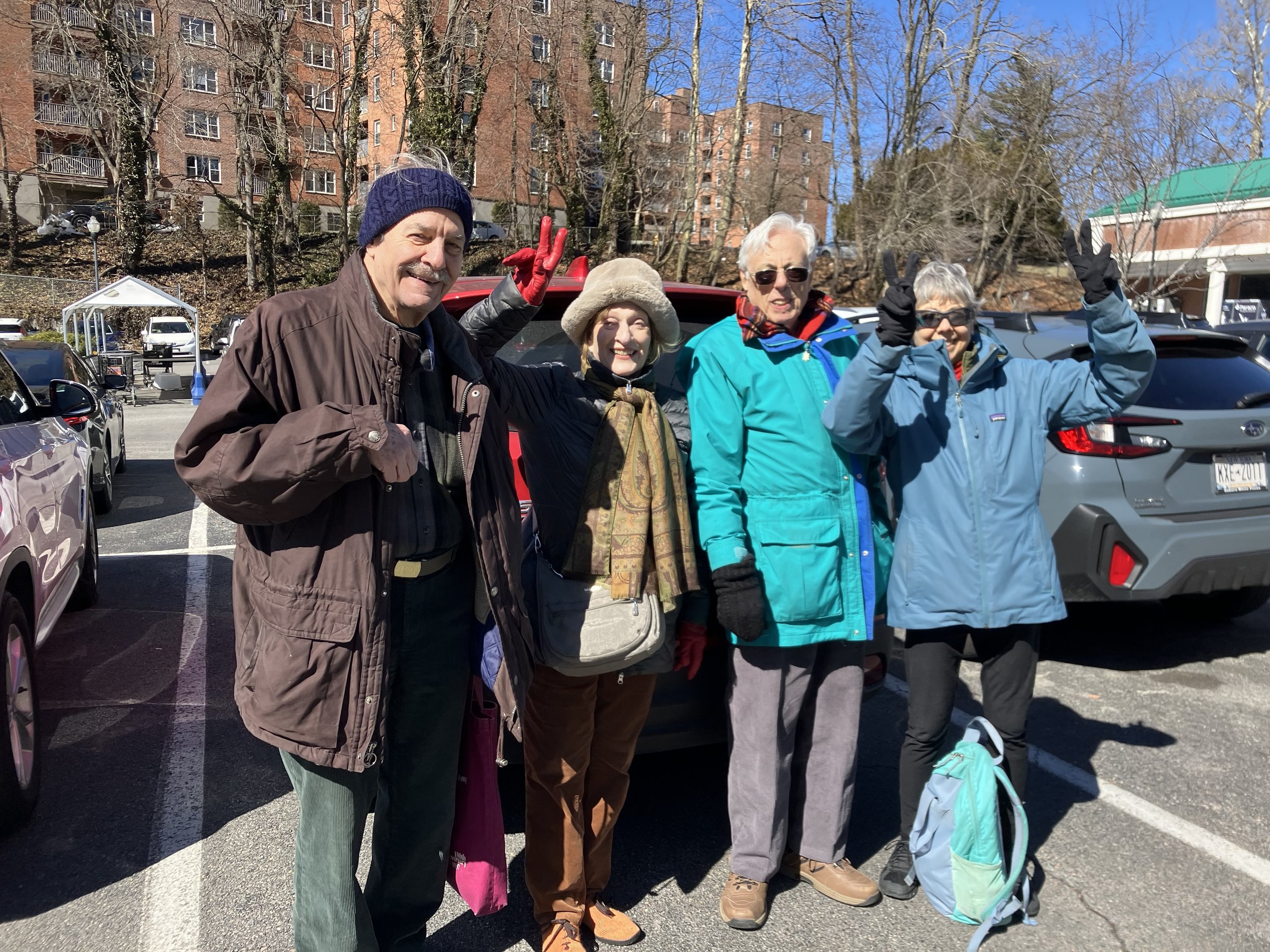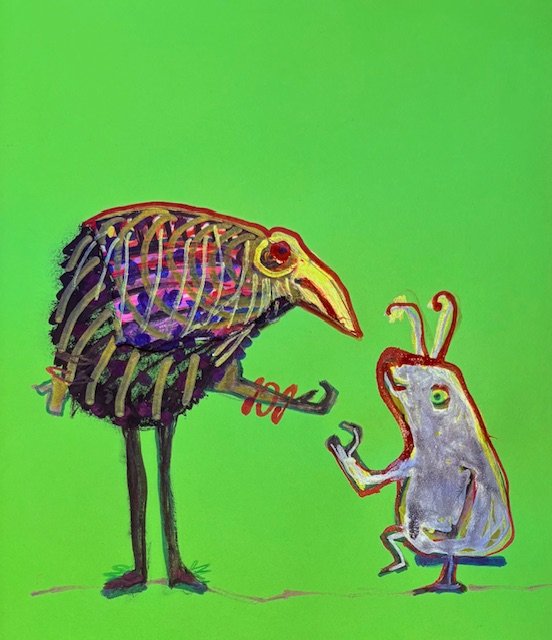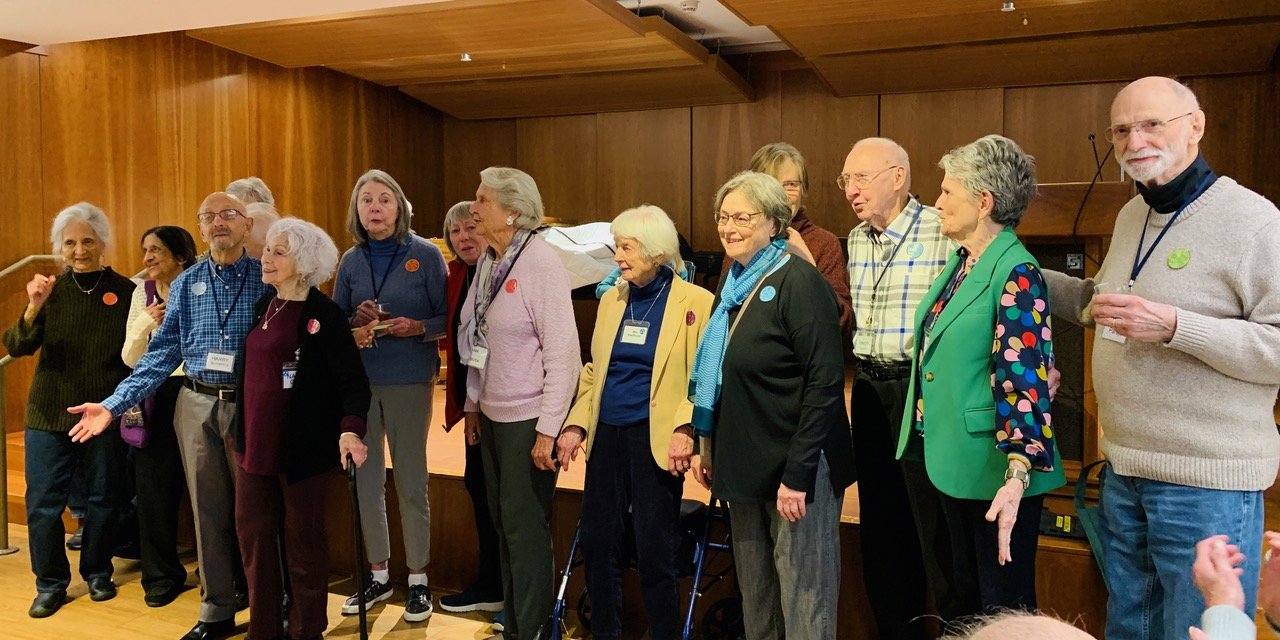Compassion
Art and photo by Sheila Benedis

Art and photo by Sheila Benedis

Kendal Daffodils
Photo by Joe Bruno

Snowdrops in Rockwood Park
Photo by Aruna Raghavan
Last week, Kendalites set out for New York Historical (formerly the New York Historical Society) to roam the exhibits and enjoy the City.
The “We the People” exhibition featured an Oval Office replica at a third of the size of the White House version, shown in the style of the Reagan administration (note the jelly bean jar). Visitors were encouraged to try it out—and Carol Levin was one who did. The first executive decision: which jellybean to test out. Her campaign slogan: “First do no harm.”

Madam President Carol Levin
Photo by Marianne Bloomfeld
Another distinctive feature of the exhibit was the “We the People” sign—made of shoelaces.

Photo by Marianne Bloomfeld
Peter Roggemann noticed a Kendal-related feature in an exhibit on New York steamships: a model of the Mary Powell.

Photo by Peter Roggemann
Kendalites of every ilk recognized their individual right and responsibility to take part in their democracy. And that’s what several did on several occasions over the past week or so.

Hastings-on-Hudson, NY

Pearl River, NY

Pearl River, NY

Tarrytown, NY

Tarrytown, NY

Tarrytown, NY
Photos by Mimi Abramovitz
Each year, we have a lovely gathering to remember those who have passed in the year before. Every year, at the end of the gathering, we, together, recite “We Remember Them.”
In 2022, Kamal Bahary and his beloved partner, Susan Blackwood, joined our community. Sadly, late in 2023, we lost Susan; and last year Kamel passed. This year, The Baharys have chosen to memorialize them both in our community, replacing the weather-weary pergola with a lovely gazebo.

Stage 1

Stage 2
Looking again at “We Remember Them,” it seems like such a wonderful choice of memorial for Kendal on the Hudson:
We Remember Them
At the rising sun and at its going down; We remember them.
At the blowing of the wind and in the chill of winter; We remember them.
At the opening of the buds and in the rebirth of spring; We remember them.
At the blueness of the skies and in the warmth of summer; We remember them.
At the rustling of the leaves and in the beauty of the autumn; We remember them.
At the beginning of the year and when it ends; We remember them.
As long as we live, they too will live, for they are now a part of us as We remember them.
When we are weary and in need of strength; We remember them.
When we are lost and sick at heart; We remember them.
When we have decisions that are difficult to make; We remember them.
When we have joy we crave to share; We remember them.
When we have achievements that are based on theirs; We remember them.
For as long as we live, they too will live, for they are now a part of us as, We remember them.
Thank you, William, Susan, Emil, and Laura

Confused, desperate, getting to the end of your rope—or just have questions?
Good News: The Computer Committee will have a Help Session on Friday, March 28th at 1 PM in the Gathering Room.
Bring your laptop, tablet, or phone for help from your fellow residents.
The first meeting of the Ad-Hoc Medical Care Committee is this week: March 27. The quickly changing medical industry of today has made Kendal’s medical-care commitments problematic, to say the least. The ad-hoc committee was created in the effort to identify ways to better answer those commitments. It is made up of members of the administration, KoH Board members, and residents knowledgeable about medical care.
Members are, in alphabetical order:
Jessica Baron, Resident, retired physician
Jo Cameron, Resident
Jean Eccleston, CEO
Erin Hennessey, Resident Care Center Manager
Ellen Ottstadt, Director of Resident Services
Hank Schacht, Resident, KoH Board member
Claire Tenney,, Resident, retired physician
Mike Kornfeld, Resident, retired physician
Jeff O'Donnell, Resident, retired nurse practioner
Art Vecchiotti, Resident, retired physician
Lisa Wacht, Director of Health Services
Sharon Wexler. KoH Board member, BsN, RN, Ph. D

Sadly, the Weekly Low-Stakes Poker Game, this past week, was cancelled due to the unexpected lack of actual Low-Stakes Poker players. Some were excused due to a virus. While that certainly is acceptable, others actually claimed to have “family duties” to attend to. Imagine!
As a result, no one landed the financial windfall consistent with the group’s weekly tournament. The win the week before was a bountiful $16!
So, the call goes out to all levels of poker experience: Come join us! Wednesday nights, 7 pm. The aim is fun, not financial windfall. Fear not any Atlantic City high-rollers joining in. All skill sets are welcome. Stakes are 25-50 cents.
Want to join the fun? Call or text John Vacher: (404) 556-0557. He’ll even come and provide a short tutorial, so you’ll fit in seamlessly your very first Wednesday night.

Pablo Picasso is one of the most recognizable names in art history, but if the painter had opted to go by his full name, it’d be a lot harder to remember. He was baptized with one first name, two last names, and 12 middle names, for a grand total of 112 letters: Pablo Diego José Francisco de Paula Juan Nepomuceno Crispín Crispiniano María de los Remedios de la Santísima Trinidad Ruiz Picasso. (The exact order and spelling vary by source.)
It’s common in Spanish-speaking cultures to have two last names, one for each parent. In Picasso’s case, Ruiz was his paternal surname, Picasso was his maternal surname, and he was given his first name, Pablo, in honor of a paternal uncle who died a few years before his birth. His many middle names each had their own meaning, too. Some are family names: He was given Diego for both his paternal grandfather and oldest uncle, Francisco de Paula for his maternal grandfather, Juan Nepomuceno for his godfather, and María de los Remedios for his godmother. Others are religious. Santísima Trinidad means Holy Trinity, while Crispín and Crispiniano come from St. Crispín and St. Crispinian, whose feast day, October 25, is also Picasso’s birthday.
Some of the artist’s earlier works are signed P. Ruiz, P. Ruiz Picasso, or P.R. Picasso — but eventually, he settled on the name known by millions today, choosing just “Picasso” for his signature.
Source: history facts.com
Contributed by Jane Hart


Contributed by Maria Harris





Art and photo by Sheila Benedis

Howlett wanted to be just like Cousin Cooldude

Fern liked blending in at parties

The piggy bank heist had been a bad idea from the start

Aquatherapy was Wickersham’s true calling

Kira wished her mother would try to look more like a normal person
Art and photos by Jane Hart

A Harbinger of Spring: The First Robin Has Been Sighted!
Photo by Harry Bloomfeld

Photo by Peter Sibley

Photo by Carolyn Reiss

Photo by Harry Bloomfeld

Photo by Harry Bloomfeld

Photo by Marianne Bloomfeld

Photo by Joe Bruno

Photo by Edward Kasinec

(Yes, play on words intended . . . )
Photo by Carolyn Reiss

Photo by Carolyn Reiss

Phishing and Scamming have picked up speed all around us—in phone calls and in emails, especially in the Senior population.
Do NOT give anyone you don’t know cash or gift cards, especially in person
Do NOT accept phone calls from the “bank” or “cable company,” etc. Always tell them you will call them back. Do not accept a call-back number they give you. Get the number from the internet or the phone book.
If you have any questions, check with Jean Eccleston (CEO), Carmela Carino (CFO), or Ellen Ottstadt in Resident Services.
Sage Advice from the Kendal Administration

As spring is springing, the next Computer Committee will be meeting—and all are welcome to attend.
Friday, March 21, 1 pm, in the Garthering Room
There will be lots of things to discuss, including:
the new Video-on-Demand,
the new Icon (Catie replacement)
The next help session to be held the following week, March 28, 1 pm, in the GR
Even if the only thing you know how to do is push the On button to your computer, you may find the discussion interesting.

A legend of American highways, most people would never guess this brand began in Brooklyn. The history dates back to John M. (“Jack”) Mack getting a job at Brooklyn carriage and wagon company Fallesen & Berry in 1890. By 1893, Jack and his brother Gus had bought the company and by 1900 they had opened their first bus manufacturing plant on Atlantic Avenue. They added the brand name “Manhattan” to their vehicles and the company took off from there.

Jack Mack

Recognize his symbol? You’d think Dixie Cups hailed from the heart of the southland, but this trademark owes its origins to Chelsea in Manhattan. It was actually a bit of laziness that gave the cup its name—the headquarters at 220 W. 19th St. had a tenant named Dixie Dolls, which took that name because the owner didn’t bother to switch a sign from a previous tenant. When the “Health Cups” name was a fail, the cup manufacturer asked his neighbor if he could borrow the Dixie moniker and the rest is trademark history.

If you guessed Thomas’ English Muffins, you got it right. In 1880, Samuel B. Thomas opened the first Thomas’ bakery in New York City, after emigrating from England. Renovations by residents in an apartment building at 337 W. 20th St. in 2006 revealed one of the brand’s original ovens.

Samuel B. Thomas
Source: “Made in NYC,” City Guide, March 20, 2024
Contributed by Bobbie Roggemann

March 12’s Grand Winner: Norman Sissman, with $16! [Insert uproarious cheers and applause]
The aim is fun, not financial windfall. Fear not any Atlantic City high-rollers joining in. All skill sets are welcome. Stakes are 25-50 cents.
Want to join the fun? Call or text John Vacher: (404) 556-0557. He’ll even come and provide a short tutorial, so you’ll fit in seamlessly your very first Wednesday night.


Contributed by Mimi Abramovitz





You may think you have a sweet tooth, but it likely doesn’t compare to the sugar craze that swept through the English upper crust in the 16th century. Due to colonial trade, sugar — a rare seasoning and preservative in the medieval period — flowed into Elizabethan England. Yet because of its high cost, the sucrose could only be purchased by the wealthy. The treat became the central ingredient of lavish banquets, and cookbooks of the well-to-do began to collect delectable dishes made with this new confection. However, sugar’s deleterious dental effects weren’t as well known at the time, and the most high-profile victim of this sweet ignorance was none other than Queen Elizabeth I herself.
It was no secret that the queen possessed a legendary sweet tooth; historians say she even used a sugar-based toothpaste to polish her teeth, which 10 out of 10 dentists don’t recommend. In 1599, a German traveler named Paul Hentzner described the 65-year-old queen and revealed what a lifelong sugar addiction can do: “Her Lips narrow and her Teeth black… a defect the English seem subject to, from their too great use of sugar.” Yet the queen’s black, rotting teeth didn’t detract from her appeal. Because only the rich could afford sugar (and the tooth decay it engendered), black teeth became seen as fashionable, and people would artificially blacken their teeth with soot to fit in, a fad that eventually faded after the reign of Elizabeth I.
Source: historyfacts.com
Contributed by Jane Hart

Nunzio, the world-famous fish choreographer, saw raw talent in the Clearwater tank

Mary Sue had been an Avon cosmetics rep and Cal had sold Electrolux vacuums, and they still loved to meet in doorways

It would have been a five-star resort, but it had only the one little unisex restroom

Even the second graders knew that Ms. Cordwood’s bark was worse than her bite

The morning stretch class was spirited, as usual
Art and photos by Jane Hart

Art and photo by Sheila Benedis
© Kendal on Hudson Residents Association 2015, 2016, 2017, 2018, 2019, 2020, 2021, 2022 all rights reserved. Please do not reproduce without permission.
Photographs of life at Kendal on Hudson are by residents.